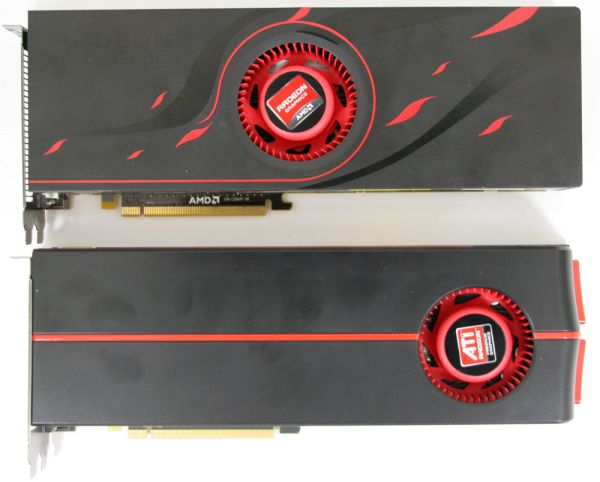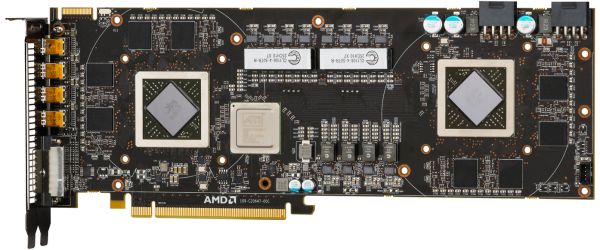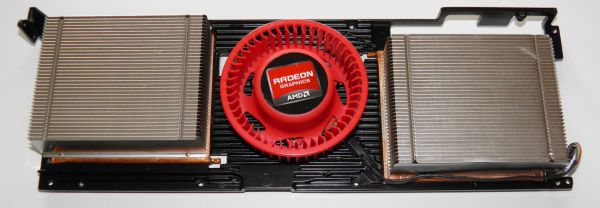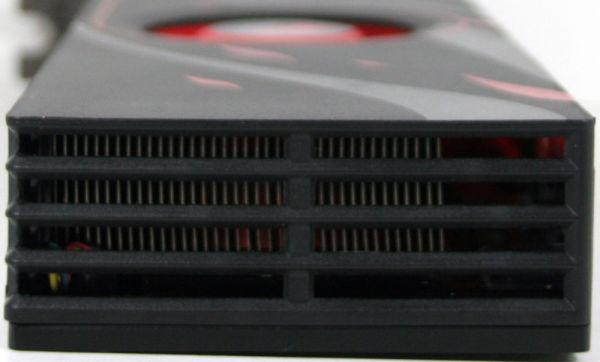AMD's Radeon HD 6990: The New Single Card King
by Ryan Smith on March 8, 2011 12:01 AM EST- Posted in
- AMD
- Radeon HD 6990
- GPUs
Meet The 6990
If you recall our coverage on the 5970, we found a few areas where AMD was lacking. The cooling on the 5970 was sufficient to run the GPUs even at 5870 clocks and voltages, however the cooling on the VRMs was lacking, leading to real world programs trigging the VRM thermal protection mechanism; and while this was within safety guidelines, it’s not a comfortable place to be for long term operation. This ultimately led to us writing off the 5970OC as a 100% reliable product, sticking to recommending the 5970 solely at stock speeds.
The design of the 6990 in turn reads very much like a response to our findings in true engineering fashion. Furthermore for the 6990 AMD not only had to take a look at the 5970’s weaknesses, but also how to handle an even greater power load. The result is that the 6990 is distinctly different from the 5970 before it.
Compared to the 5970, the 6990 is ever so slightly shorter, thanks in large part to the fact than the 6000 series casing is more squared off compared to the 5000 series’ tapered design. As a result it comes in at 11.5” for the PCB (the same as the 5970), and with casing a full 12” long compared to the 5970’s 12.16”. This means that the 6990 has effectively the same space requirements as the 5970, cooling notwithstanding.
Meanwhile it’s the fan however that is going to catch the most attention and this is where we’re going to dovetail in to cooling. The 5970’s traditional blower had its strengths and weaknesses, the strengths being that blowers are relatively forgiving about a case’s ability to exhaust hot air, and the weaknesses being that the GPU (and VRMs) closest to the fan received better cooling than the farther GPU. The VRMs proved to be particularly problematic, as they could overheat well before the GPUs did and AMD does not spin up their fans based on VRM temperatures.
Correcting for this and at the same time allowing for even greater heat dissipation, the rear blower design is out. Its replacement is a design that we’ve seen in 3rd party cards before such as the Asus ARES 5870X2, but not in a reference design: a center-mounted fan/blower with a GPU to each side. The difference is critical and indeed cannot be understated: a rear blower channels most hot air outside of the case, while a center-mounted blower effectively splits the card in two, with one GPU + supporting chips being exhausted outside of the case, and the 2nd GPU + supporting chips being exhausted inside the case. The design is still enclosed, so everything goes out either the front or back of the card while fresh air is pulled in the center.
With the replacement of the blower, so has gone the heatsink. The 5970’s single large vapor chamber + heatsink design has been replaced in favor of a segmented heatsink, further driving home the concept that the 6990 is closer to 2 video cards sharing 1PCB than it is 2 GPUs on one card. Each heatsink in turn is connected to the GPU via its own vapor chamber, resulting in the GPUs being fully isolated from each other as far as cooling is concerned.
Even the thermal paste connecting the GPUs to the vapor chambers has been changed for the 6990 – AMD has replaced traditional paste with a phase change material. Phase change materials – pastes/pads of material that melt and solidify based on temperature are nothing new, however they’re still exotic; material similar to what AMD is using is not readily available as paste is. AMD even went so far as to suggest that reviewers not directly disassemble their 6990s as it would require a new application of phase change paste in order to achieve the same efficiency as the original material. The net result of all of this by AMD’s numbers is that the phase change material is 8% better than the regular paste they’ve been using.
Rounding out our focus on cooling is the VRMs, which have been relocated in order to correct for the 5970’s limited VRM cooling capabilities. The VRMs and controllers are now at the center of the board – now they’re cooled before the GPUs or RAM modules are. The profoundness of this is twofold: not only is it an improvement on the 5970, but with the 6990’s higher power consumption VRM cooling is even more important. As with the 6970, voltage regulation is supplied by Volterra MOSFETs and controllers.
All told, while the 5970 was designed to handle and dissipate 400W of heat, the 6990 is officially designed for 450W. In practice, at its limits in our test rig this is closer to 500W. To handle and dissipate that much heat in roughly 72in3 of space is nothing short of amazing.


















130 Comments
View All Comments
james.jwb - Tuesday, March 8, 2011 - link
I doubt it. That would be 80 dBA at ear level compared to whatever Ryan used. At ear level it's going to be a lot lower than 80.Still, that doesn't take away the fact that this card is insane...
Belard - Tuesday, March 8, 2011 - link
The card needs 3 slots to keep cool and such. They should have made a 2.5-slotted card, but with a bit of a twist.Channel the AIR from the front GPU chamber into a U-duct, then split into a Y that goes around the fan (which can still be made bigger. The ducts then exhaust out the back in a "3rd slot". Or a duct runs along the top of the card (out of spec a bit) to allow the fan more air space. It would add about $5 for more plastic.
Rather than blowing HOT air INTO the case (which would then recycle BACK into the card!
OR - blowing HOT air out the front and onto your foot or arm.
Noise is a deal killer for many people nowadays.
strikeback03 - Tuesday, March 8, 2011 - link
That ductwork would substantially reduce the airflow, making a sharp turn like that would be a large bottleneck.burner1980 - Tuesday, March 8, 2011 - link
I´m always wondering why reviews always neglect this topic. Can this card run 3 monitors @ 1920x1080p 120 HZ. 120 HZ monitors/beamer offer not only 3D but foremost smooth transitions and less screen tearing. Since this technique is available and getting more and more friends, I really would like to see it tested.Can anybody enlighten me ? (I know that Dual link is necessary for every display and that AMD had problems with 120 HZ+eyefinity) Did they improve?
silverblue - Tuesday, March 8, 2011 - link
...with two slightly downclocked 6950s. Alternatively, a 6890, albeit with the old VLIW5 shader setup. As we've seen, the 5970 can win a test or two thanks to this even with a substantial clock speed disparity.The 6990 is stunning but I couldn't ever imagine the effort required to set up a machine capable of adequately running one... and don't get me started on two.
Figaro56 - Tuesday, March 8, 2011 - link
I'd love to see Jessica Alba's beaver, but that aint going to happen either.qwertymac93 - Tuesday, March 8, 2011 - link
AUSUM SWITCHhttp://img202.imageshack.us/img202/8717/ausum.png
KaelynTheDove - Tuesday, March 8, 2011 - link
Could someone please confirm if this card supports 30-bit colour?Previously, only AMD's professional cards supported 30-bit colour, with the exception of the 5970. I will buy either the 6990 or Nvidia's Quadro based on this single feature.
(Because somebody will inevitably say that I don't need or want 30-bit colour, I have a completely hardware-calibrated workflow with a 30" display with 110% AdobeRGB, 30-bit IPS panel and the required DisplayPort cables. Using 24-bit colour with my 5870 CF I suffer from _very_ nasty posterisation when working with high-gamut photographs. Yes, my cameras have a colour space far above sRGB. Yes, my printers have it too.)
Gainward - Tuesday, March 8, 2011 - link
Just a heads up for anyone buying the card and wanting to remove the stock cooler.... There is a small screw on the back that is covered by two stickers with (its under the two stickers that look like a barcode). Well removing that you will then notice a void logo underneath it... I just wanted to point it out to you all...Didnt bother us too much here seen as ours is sample but I know to some droppin £550ish UK is quite a bit of cash and if all you are doing is having an inquisitive look it seems a shame to void your warranty :-S
mmsmsy - Tuesday, March 8, 2011 - link
I'd like to know how do you benchmark those cards in Civ V. I suppose it's the in-game benchmark, isn't it? Well, I read some tests on one site using their own test recorded after some time spent in the game using FRAPS and I'm wondering if using the in-game test is that really different scenario. According to the source, in the real world situation nVidia cards' performance show no improvement whatsoever over AMD's offerings. If you could investigate that matter it would be great.